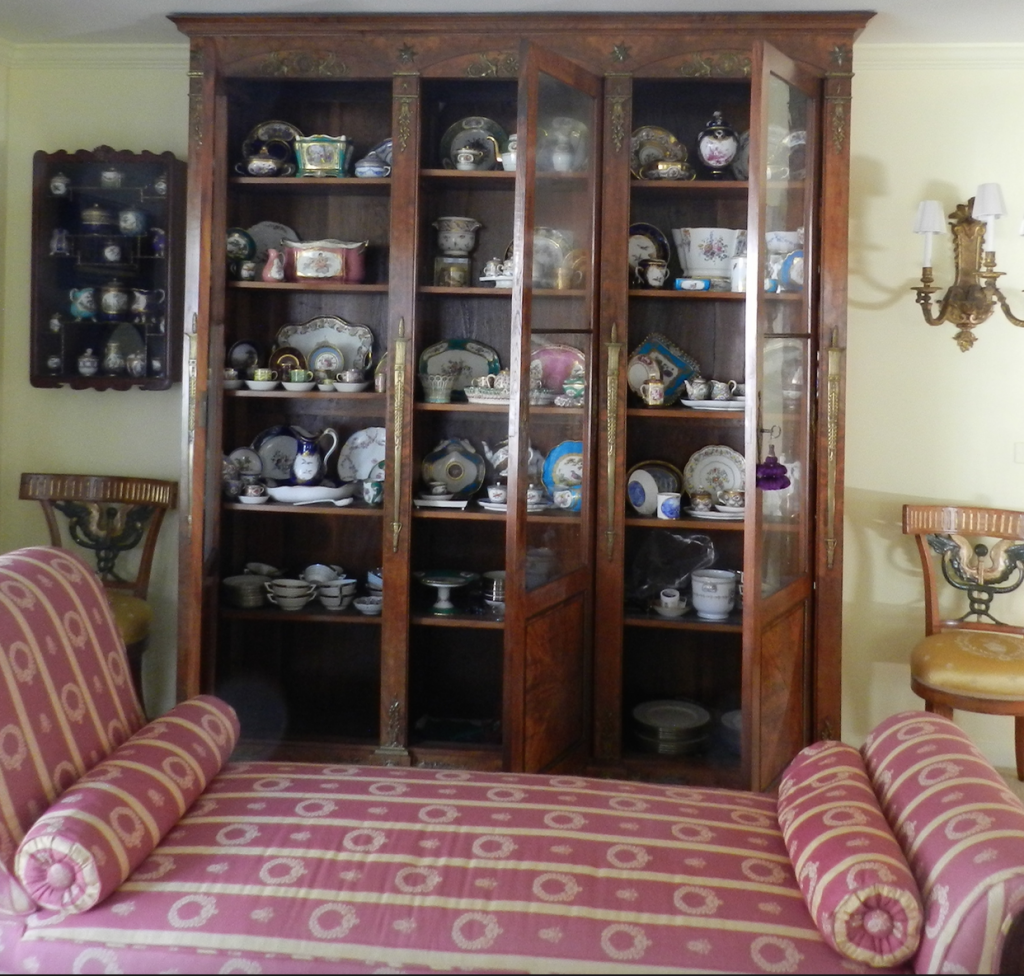As Professor Anne Higonnet has told me a couple of times this semester, “the stars seem to be aligned for this project” and she certainly was right today. This morning she and I had the pleasure of visiting a private collector of Sèvres 18th C porcelain at her home in Scarsdale. Not only did our hostess tell us some marvelous stories of her collecting over the years, but she took a great number of pieces out of their display cabinet (a magnificent piece in its own right; see above image) for Professor Higonnet and I to examine up close and graciously allowed me to photograph some!
Upon crossing the threshold of the collector’s home, I was surrounded by magnificent eighteenth and nineteenth century antiques, decorative arts, and prints. The aesthetics of the home uphold a unique personality which, I later came to understand, speaks wonderfully and accurately of the collector to whom these objects belong. Our hostess lead us into the living room where her Sèvres collection is on display, and proceeded to give us a little background on her collecting history and where she acquired her love of decorative arts. It turns out that our collector grew up in the tri-state area and her mother was an artist who ran her own design business. Growing up, the collector was dragged to and from antique shows where her mother engrained the importance of styles, aesthetics, and visual traditions. A quote that stuck with me in particular is when the collector said “when I grew up I knew I wanted to collect, it’s in my psychology; my mother didn’t have the inclination to collect but she had a fine eye and loved to be surrounded by aesthetically beautiful things.”
With a brief history of the ‘collectress,’ under our belts, the real fun began. The first piece that she pulled out was a 1756 platter from Vincennes; a magnificent early example of French porcelain, this piece shows signs of early color experimentation as its ground is not perfectly toned and in some areas the ground color has pooled. One after another incredible example of 18th century soft-paste porcelain color, style, and artistry kept being placed in front of me and my camera lens. I got to examine etching marks in the gold details of a variety of pieces, see signatures, and see an outstanding arrangement of how the green Sèvres color evolved during the early years of Sèvres ground color experimentation.
Like I mentioned in an earlier blog post, Professor Higonnet has planted a ‘seed’ in my head to create a digital animation of how a person would have sipped out of a teacup and interacted with both the teacup and its saucer (©Avery Schroeder 2015). At the home of the collector this morning, I was able to capture incredible stills of the gradual movement of teacup from saucer to human hand all the way up to human lips and then replaced perfectly in its space on its saucer. I truly could go on and on an on about today’s special visit–I am eternally grateful to our wonderful hostess and magnificent collector who so graciously opened her home for my educational exploration.
I learned a great deal too, from the collector this morning. She answered some of my standing questions regarding color and she added a handful of fundamental texts to my bibliography–which, I will be ordering this weekend to read in the coming weeks. Of this handful of books, the collector introduced me to the catalogue of Edouard Garnier’s Sèvres porcelain prints; in her dining room, the collector has curated Garnier prints (original copies/first edition copies) upon the four walls of the room. I was immediately drawn to these prints as I have only come across one in the literature I’ve read thus far and it happens to be my most favorite image, drawing or photograph of Sèvres. I was ‘over the moon,’ as they say, to realize that ‘my favorite image’ is one of many and now to have a catalogue soon to be at my fingertips of a vast array of similar images.
Today was definitely a turning point in my research for my thesis thus far. I have met a passionate and incredibly intelligent collector, I have interacted first hand with a teacup and saucer so I can better annotate the experience to the world, and I have primary image resources that are beyond anything I could have dreamed.
